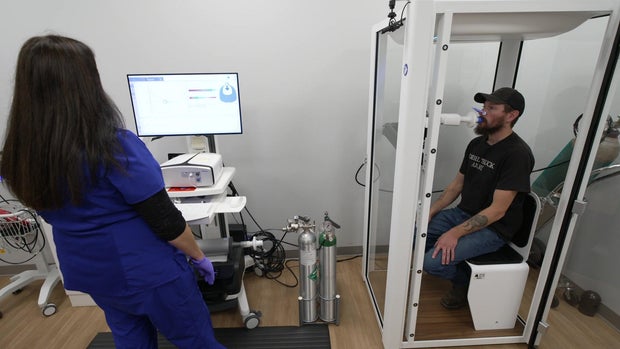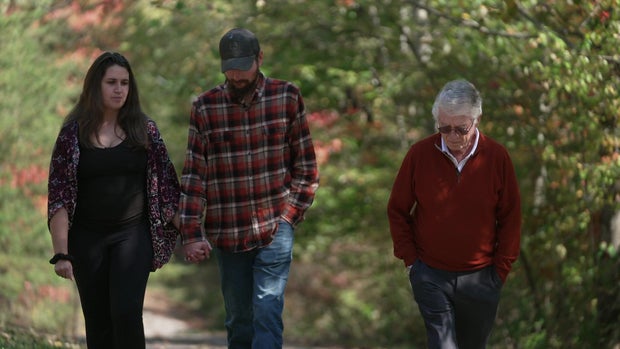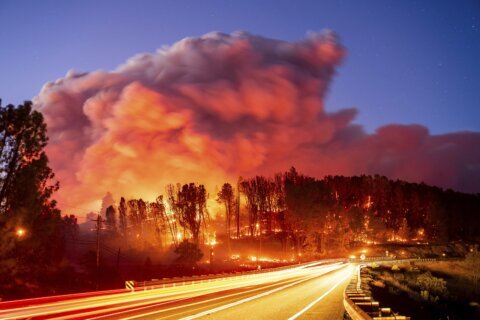▶ Watch Video: Black lung threat increasing among coal miners
West Virginia, October. Friday night football. The Oak Hill Red Devils are hosting the Buckhannon Buccaneers. In small town America, Friday night football is a big deal.
Zach Davis, head coach for the Buccaneers, described what’s ahead for the area’s young people: “Our kids, some are gonna go to college and then go into some sort of professional career. A lot of ’em will go be a blue-collar worker, whether that’s at Walmart, or a local business, or some sort of convenience store.”
“I notice you’re not mentioning the mines,” said Koppel. “This used to be – this is coal country right here.”
“Used to be,” said Davis. “I think a couple of our kids I know of have been in the mines since I’ve been here, but not very many.”
Don Barrett spent 23 years in the coal mine. Twenty years ago, he said, half of the kids on the football field would have ended up in the mines. But now? “Today, no chance of going in the coal mine,” Barrett said. “I graduated high school on a Friday; Monday morning I was in a coal mine. My dad worked the coal mine, my granddad worked the coal mine, my brothers work the coal mine. Still is coal country, but not like it used to be.”
Back then, he said, “Everybody was working, there was jobs everywhere. People were buying new homes, new cars. Life was good!”
That was the upside. Mining, of course, was always a dangerous job, and one in every five miners has for years ended up with black lung. “Black lung is a bad disease,” said Barrett. “I have problems with breathing. You have coughing, you just suffer where you can’t do the things that you used to do.”

At the New River Health clinic, Kevin Weikle is taking a pulmonary function test; it identifies just how badly-impaired his lungs have become. The test confirms what he and respiratory therapist Lisa Emery already know: Kevin’s black lung is so severe that he can no longer work in the mines.
What’s different about Kevin is his age. Used to be, black lung didn’t force a man out of the mines until he was in his late fifties or early sixties. Kevin is just 34.
Kevin has been a coal miner almost half his life. At age 18, he was suddenly making more money than he ever dreamed possible: “The first six months underground at $12 an hour, [I] made $76,000 in six months,” he said. “That’s how much I worked. Sometimes I wouldn’t even go home. I’d go out, sleep in the parking lot, get back up, go back in. I was told that I’d break myself long before I broke the company, so I could work as much as I wanted to!”
The first thing he bought was a truck. “Yup. I went and bought a brand-new F-250 diesel. You grow up with little, so when you start making that kind of money … Yeah, those was the good days.”
Life started getting serious, he said, when his son was born. “Then, you look at stuff different,” he said. “You really realize the dangers, when you have something to live for, instead of just yourself. … It’s something that you expect to get when you’re old, not 34.”

Kevin has what he calls “complicated black lung.” “My lungs is turning to rock,” he said.
Kevin is just one of many young miners showing up at the clinic. “Our rates of black lung in Central Appalachia are skyrocketing,” said Emery.
Why? “It seems that the miners are having higher exposure levels to silica dust.”
Because miners now have to drill through more rock to get to the coal, they’re experiencing rock dust – finer, smaller – that’s more damaging to the lungs even than the coal dust is.
The Mine Safety and Health Administration, or MSHA, has proposed a new rule that would lower miners’ exposure to respirable crystalline silica. It’s a rule that needs congressional approval, but still faces Republican opposition.
“Sunday Morning” contacted several mining trade associations; all declined the opportunity to comment.

William “Bolts” Willis retired from the coal industry years ago, but he’s still in the union; in fact, he’s president of United Mine Workers Local 8843. He told Koppel, “We’ve already got the limits for black lung coal dust. This is silica dust, which has been there, present, all the time, and it cuts your lungs.”
But the proposed rule, he says, may change nothing: “It may not, because there’s not any teeth in what they’re doing to make the companies comply with this.”
“Roscoe” (not his real name) is a 34-year-old working coal miner who fears that he already has black lung. He contends that the mines routinely break the rules, and that if his real name came out, he’s probably never have a job in the coal industry again.
“Coal mining isn’t a bad job,” he said. “I do love coal mining, but it doesn’t have to be the way it is.”
Roscoe explains what happens when an inspector comes on mine property: “Everybody’s crossing their T’s and dotting their I’s. Everything’s done right. When we’re underground, and an inspector pulls up on that property, before he ever gets out of that vehicle, the dispatcher calls underground and lets every section know that there’s an inspector on the property. So, by the time the inspector comes up to the section, everything’s right.”
How many years has that been going on? “That’s been going on since I’ve been in the coal mine,” Roscoe said. “They keep raising these dust laws and these ventilation laws for these coal companies, thinking that it’s gonna help this black lung matter. But it’s not.
“The laws that are in effect now would work, if coal companies actually obeyed them and took care of their men fulltime, instead of whenever there’s just an inspector on the section,” he said.
“The only thing that mining companies understand is money,” said Sam Petsonk, who represents miners in their lawsuits seeking benefits for black lung. [Coal companies rarely provide such benefits without being sued.] “We are seeing many young miners, hundreds in this region where I practice law, as young as their 30s, losing over a quarter of their lung to pure rock dust. It’s a crisis. We’ve never seen so many young miners with such short exposures becoming so extremely sick.”
Koppel said, “So, for years now, you’ve been trying to get an improvement in the regulation, which you now have.”
“Unfortunately, the rule lacks any significant enforcement mechanism,” said Petsonk. “Before the rule is finalized, the Department of Labor must add significant enforcement mechanisms and specified monetary penalties for violating this rule. Or else, unfortunately, we have no reason to expect that the rate of black lung and silicosis will decline in this country.”
Kevin Weikle explained that a dust pump is used to measure the dust in the air, taking in that dust and trapping it in a filter. But, he said, the mines stack the deck when it comes to testing for air quality. “Company pumps, you would keep them in clean air, to make sure that they passed,” he said.
“So really, what the inspectors were seeing was not a normal shift?” Koppel asked. “If the inspectors had actually seen what the real reading was, what would the difference have been?”
“Significant!” Weikle laughed.
“And what would that have meant?”
“A lot of changes, I mean, in ventilation. They’d up the air required on each machine. It would’ve been more expensive. And a great loss of production.”
“You think that happens a lot?”
“I know it does,” Weikle replied. “Anybody says it don’t is lying.”
The disease, as Weikle knows, is not reversible. His black lung is progressing: “It will progress whether I’m in the dust or not. It’s still gonna grow and lead to probably a lung transplant at some point in time. If I’m lucky.”
And the very considerable expense of a lung transplant is only part of the problem. There are wait lists and limited locations where lung transplants are performed, which can mean moving entire families for months at a time.
Television programs don’t dwell much on what comes next: the unexpected expenses, the likely relocation, the shifting responsibilities. Kevin and his wife, Megan, have four young children. What lies ahead is daunting for all of them. She said, “It’s been really depressing.”

Koppel asked, “All of a sudden, you got a lot more responsibility than you ever thought you were gonna have?”
“Yup, lot of stress,” she replied.
The coal company laid it out for Kevin Weikle half a lifetime ago: he’d break himself before he broke the company. And that’s pretty much how it is.
For more info:
- New River Health clinics
- United Mine Workers Local 8843
- Respirable Crystalline Silica: Notice of Proposed Rulemaking (Mine Safety and Health Administration)
Story produced by Sari Aviv. Editor: Ed Givnish.






